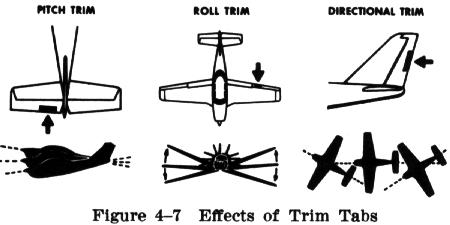Trim Tabs. When an airplane's flight conditions (attitude, airspeed, loading, etc.) and configuration are changed, the control pressures required to maintain the new flight conditions are affected by the resulting changes in aerodynamic forces. The

| The secondary flight controls are the trim tabs, balance
tabs, or servo tabs. They are used for trimming and balancing the airplane
in flight and to reduce the force required of the pilot in actuating the
primary flight control surfaces. These tabs are really small airfoils attached
to, or recessed into, the trailing edge of the primary control surfaces
(Fig. 4-7).
Trim Tabs. When an airplane's flight conditions (attitude, airspeed, loading, etc.) and configuration are changed, the control pressures required to maintain the new flight conditions are affected by the resulting changes in aerodynamic forces. The |
 |
A trim tab is a small, adjustable hinged surface, located on the trailing edge of the aileron, rudder, or elevator control surface. It is used to maintain balance in straight and level flight and during other prolonged flight conditions without the pilot having to hold pressure on the controls. This is accomplished by deflecting the tab in the direction opposite to that in which the primary control surface must be held. The force of the airflow striking the tab causes the main control surface to be deflected to a position that will correct the unbalanced condition of the airplane.
In many airplanes the trim tabs may be adjusted by controls in the cockpit, while in some of the older types they may be adjustable only on the ground. Those which can be controlled from the cockpit provide a trim control wheel or electric switch. To apply a trim force, the trim wheel or switch must be moved in the desired direction. The position in which the trim tab is set can usually be determined by reference to a trim indicator.
Balance Tabs. Balancing tabs look like trim tabs and are hinged in approximately the same places as trim tabs would be. The essential difference between the two is that the balancing tab is coupled to the control surface by a rod, so that when the primary control surface is moved in any direction the tab automatically is moved in the opposite direction. In this manner the airflow striking the tab counter balances some of the air pressure against the primary control surface and enables the pilot to more readily move and hold it in position. These tabs also act as trim tabs as described above.
Servo Tabs. Servo tabs are very similar in operation and appearance to the trim tabs previously discussed. Servo tabs, sometimes referred to as flight tabs, are used primarily on the large airplanes. They aid the pilot in moving the control surface and in holding it in the desired position. Only the servo tab moves in response to movement of the pilot's flight control, and the force of the airflow on the servo tab then moves the primary control surface.